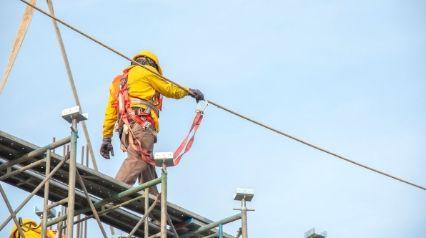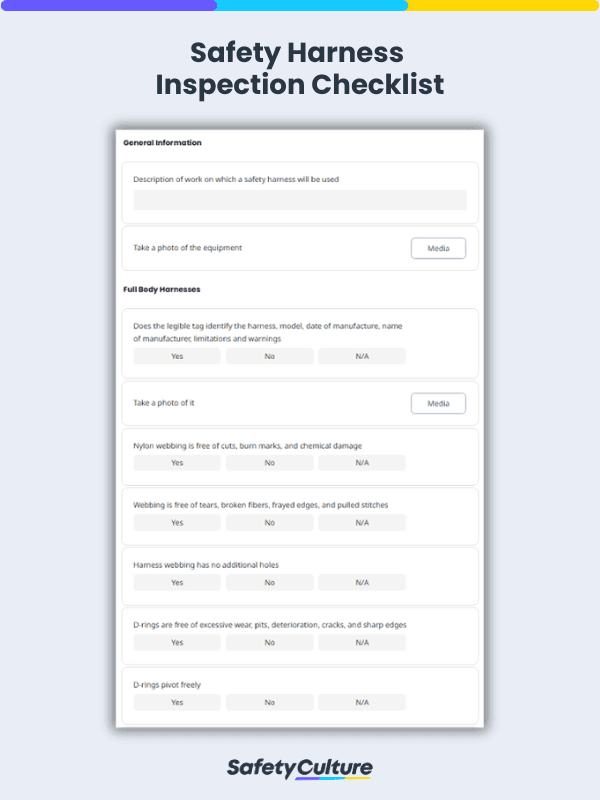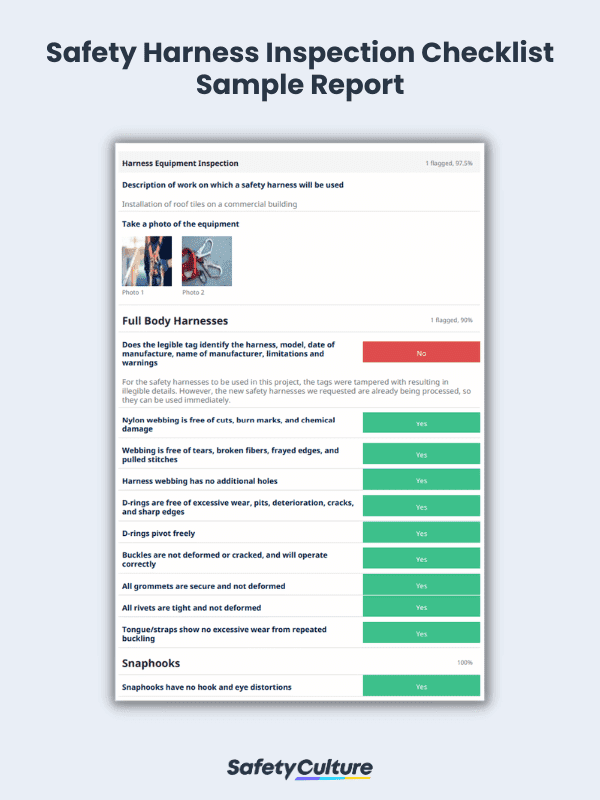What is a Safety Harness Inspection?
A safety harness inspection is ideally conducted every time a harness is going to be used by a worker who will be working at heights. Also known as a fall protection harness inspection, safety harness inspection helps keep workers safe as it involves checking if the labeling, webbing, stitching, D-rings, lanyards, and snap hook-ends of a harness are in good condition.
Importance of Harness Inspections
Occupational health and safety regulators around the world, such as the US Occupational Safety and Health Administration (OSHA), the UK Health and Safety Executive (HSE), and Safe Work Australia, require regular inspection and proper maintenance or storage of fall protection equipment. For this reason, having a safety harness inspection checklist and other fall protection checklists have become essential.
Regular inspections of safety harnesses ensure the integrity of safety harnesses and reduce the risk of falling. It can also help extend their lifespan, saving money in the long run. Harness inspections can detect wear and tear, corrosion, and other issues that, if left unattended, would lead to premature harness failure. By catching these problems early, you can ensure that your harnesses remain effective for an extended period.
Laws and Standards for Proper Use and Inspection Practices
Different countries have different legal regulations and standards to follow for the use and inspection of safety harnesses. Here are some of the most well-known standards around the world:
Work at Height Regulations 2005
This regulation from the UK mandates that all safety harnesses exposed to strenuous physical, chemical, and weather elements at work be subject to regular and ad hoc inspections in order to ensure that they are safe for use. This regulation also details other safety standards for other fall protection equipment.
The Personal Protective Equipment (PPE) at Work Regulations 1992
This UK law requires employers to cover the costs of PPE maintenance and repairs for all workers required to use them. This also puts responsibility on employers to ensure that workers are wearing the appropriate PPEs for any work being performed.
OSHA 1910.140 – Personal Fall Protection Systems
This OSHA regulation details the rules and regulations needed for all US states to follow when using, maintaining, and inspecting safety harnesses and other personal fall protection equipment. This also lists down the different gears needed for different tasks.
EN 361:2002
This regulation provides the necessary details and guidelines for the use of full-body harnesses when working at heights. Along with EN 358 and EN 355, EN 361 is one of the major regulations European countries refer to when ensuring safety for workers at heights.
What Should a Safety Harness Inspection Checklist Include?
A typical safety harness inspection checklist contains fields for the following:
- Date and time the inspection is being performed
- Inspector name
- Description of why a safety harness is necessary for the task
- Task to be done
- Photos of the equipment and safety harnesses to be used
- Presence and condition of safety harness tags and their written model, date of manufacture, name of manufacturer, limitations, and warnings
- Status of burn marks, damage, cuts, holes, cracks, deformities, and other issues on the harness, if applicable
- Condition of hooks
- Description of the type of lanyard used and its condition
- Condition of lifelines
- Recommendations
- Signature for sign-off and validity
Here is a sample report from a safety harness inspection checklist for reference:
5 Safety Harness Inspection Tips
Inspect the following for fall prevention.
- Inspect labels and tags – Always check to ensure product labeling and tagging is legible and attached to the lanyard
- Webbings and stitching – Webbing should be free from cuts, broken fibers, and other damage. Visually check for damage across the entire length of the equipment
- Inspect all D-rings and metal parts – D-rings, buckles, rivets, and grommets should be free from cracks and deformities. Visually and physically check for sharp edges and distortions.
- Inspect snap hook ends – Snap Hooks should have no hook and eye distortions. Check for evidence of corrosion or other damage.
- Check lanyards – Lanyards should be able to carry standard bodyweight. Inspect rope lanyards for broken strands. Discard lanyards with broken strands.
FAQs about Safety Harness Inspection Checklists
Whether it’s a pre-use, scheduled, or interim type of safety harness inspection, safety harnesses should be inspected only by competent persons or rescuers who can verify that the harnesses are safe for use. They are also responsible for using and managing safety harness inspection checklists.
When inspecting a full-body safety harness, workers at heights should keep an eye out for the following often-missed checkpoints:
- Impact Indicators
- Sub-pelvic Straps
- Ultraviolet Degradation
- Contamination
- Worker Competency
Safety harnesses should be inspected once a year at the minimum to ensure they are still fit for use. However, it would be best to inspect your harnesses before and after each use to better track problems and safety concerns as they happen. This can be done with a checklist, particularly with a digital one that you can have with you at all times.




